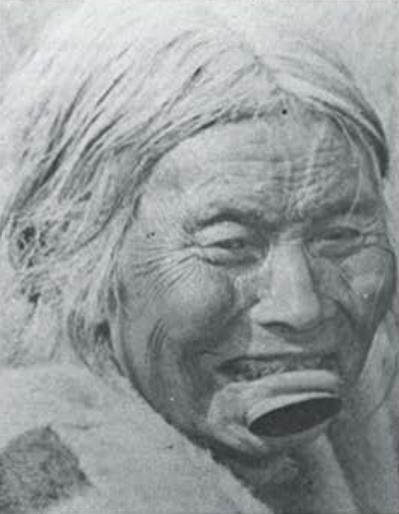Originally published in Syesis, 14, 59-80.
1981.
By Grant Keddie
This paper deals with the definition, categorization, and distribution of labrets. or lip plugs, and gives a regional synthesis of their history as known from both archaeological and ethnological studies on the Pacific Rim. from the Gulf of Georgia region in Canada to northern Japan.
Key Index Worms: archaeology, categorization, distribution, labrets. North Pacific Rim
Many problems are encountered when interpreting ethnographic, archaeological, and other written sources on labretifery. At present there is no consistent classification system used in describing labrets. A system of mutually exclusive terms is a necessity for entry into a computerized data base Part of the problem in the development of a classification system has been the confusion resulting from the practice of different age groups, as well as sexes, wearing different varieties of and/or numbers of labrets. This confusion has resulted in misleading references in the literature or a failure to recognize a labret when it was found. Another factor creating confusion involves the failure to recognize the drastic changes in the practice of labretifery that have resulted due to early European influence on native cultures.
An examination of the literature would give one the impression that the importance of labret wearing is not significant in providing information on past human behaviour. Archaeological reports, on assemblages where labrets are present, usually place them in a “miscellaneous” category with a brief description, if in fact they are mentioned al all.
This paper is intended to: (1) promote a recognition of the distribution and complexity of the practice of wearing labrets by peoples of the North Pacific Rim and (2) begin discussion on the development of a useful classification system and associated terminology pertaining to labrets. Entry of standard terms into a computer database will allow us to make both general and specific comparisons between and within labret wearing regions of the world.
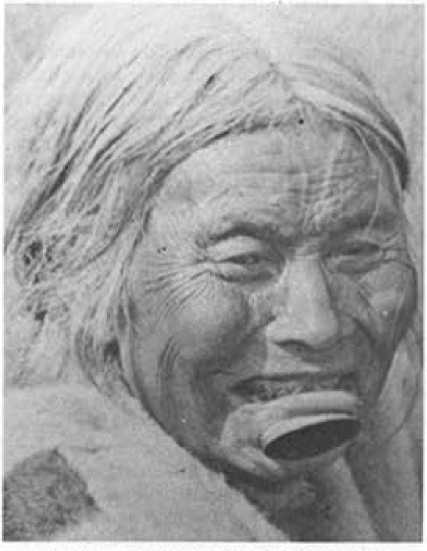
Definition of Labrets
A labret is an ornament worn in and projecting from a hole or holes pierced through the skin, usually just below the lower lip or near the corners of the mouth (Fig. 1). In the case of some African and South American groups, labrets are worn in both the upper and lower lips. They occur in various shapes and sizes and are made of various materials, such as stone, bone, wood, shell, coal, ivory, glass, copper, silver, or gold, according to the spatial and temporal context in which they occur. Labrets can be made from a single item or composed of several parts. Two basic modes of labretifery are defined in this paper according to their location on the body: one mode involves the wearing of the single, double or multi-medial labret(s) placed below the middle of the lip, and the other mode involves the wearing of lateral labrets placed near the corners of the mouth. A rarer third mode includes the wearing of both lateral and medial labrets (Fig. 2).
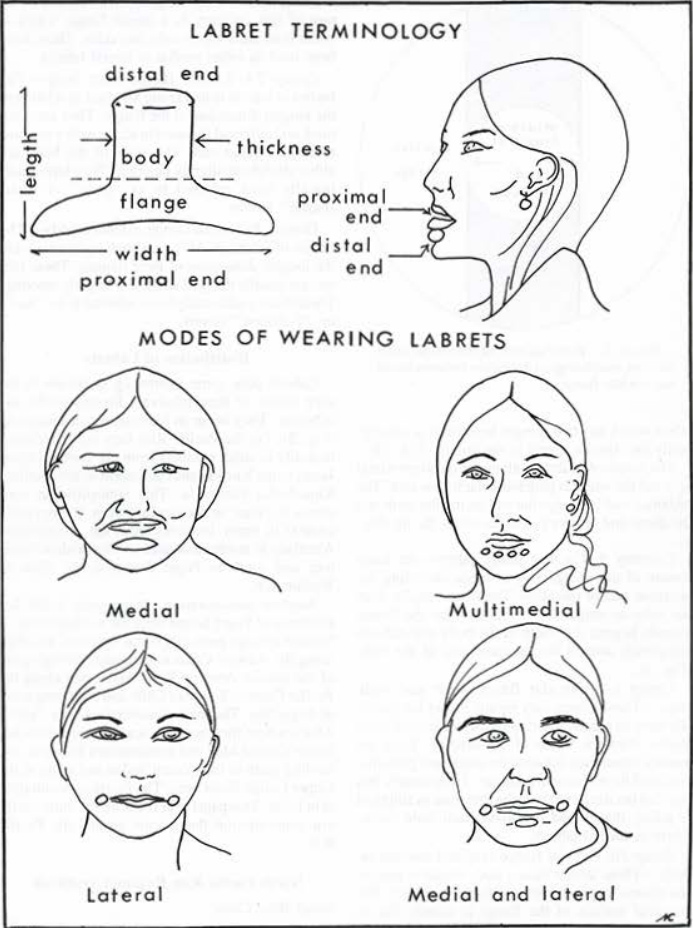
A labret is composed of two basic parts, the body (the part of a labret which extends through the lip) and the flange (a rim or projection at the base of the body of a labret) which functions to hold the labret in the lip, and which includes the proximal surface of the labret body (Fig. 3). Often, in addition, ornaments such as beads or pendants may be attached directly or by an ornament attachment hole.
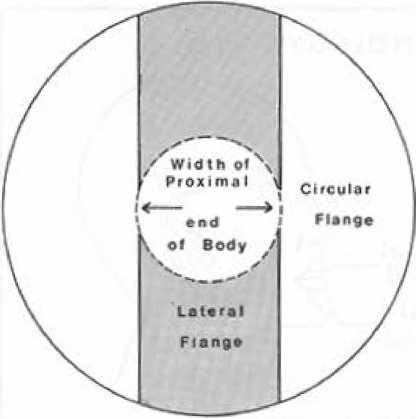
Customs associated with labrets vary considerably. During the early contact period with Europeans labrets were worn in some regions by women, in some by men, and in others by both sexes. The incision or incisions were sometimes made in the lip at an early age, often with a special instrument for the purpose. The hole was enlarged yearly by the insertion of larger labrets. or by operational enlarging of the hole at special times such as puberty and marriage. The latter occasions were often associated with a well-defined ceremonial procedure.
Explanations as to why the labret was worn vary from the prevention of kidnapping by non-labret wearers (which would seem to have some basis for promoting the practice among those Africans who were potential victims of slave traders), to explanations such as: the labret prevents women’s faces from becoming wrinkled by drawing the skin tight (Drucker 1950:261); or the custom is employed so that women would not talk too much and thereby prevent gossip which causes feuds (de Laguna 1960:120).
Some peoples on the North Pacific coast wore more elaborate labrets in the presence of visitors. Also, labrets may have occasionally had different functions on different occasions, such as was the case among the Mura of the lower Amazon River. The Mura, who had both lips pierced, for wearing one variety of labret on a day to day basis, also formerly wore tusks of the wild boar in the perforations whenever they went out to encounter strangers or their enemies in war. The function of the labrets in this case may express a desire, on the part of the wearer, to acquire the ferocious qualities of the wild boar or it may express a belief in the actual energy transference of those qualities to the wearer (Roth 1924:414-15). A completely different function such as acquiring a state of appeasement between man and walrus may be inferred by the practice of some Point Barrow eskimo who wore small walrus tusk labrets (Murdoch 1892:145) carved into the shape of actual tusks.
In general it can be stated that the labret was recognized, to varying degrees depending on the location, as a symbol of wealth, honour, bravery and beauty. It was an indicator of maturity and the privilege or obligation of the individual in connection with communal rights (e.g., Dall 1884:8, Langsdorff 1817:114. de Laguna 1960:119, Meares 1790:101). The complete function, however, can only be understood in the context of the cosmology of a specific culture.
Labret Categories
The basic categories designated here (Fig. 4) are derived from morphological templates of varieties recognized throughout the known labret wearing areas of the world and based upon shapes and relative dimensions of the flange and the body. Authors who have described labrets have traditionally focused on approximations of the two main categories presented here, but have used descriptive terminology that is perceived differently through time, such as “hat shaped” or “cuff bottom shaped”. It is common, for example, for different authors to refer to the same style of labret as “hat shaped” and “T-shaped”. For the purpose of information entry into a computer database these terms are not specific enough.
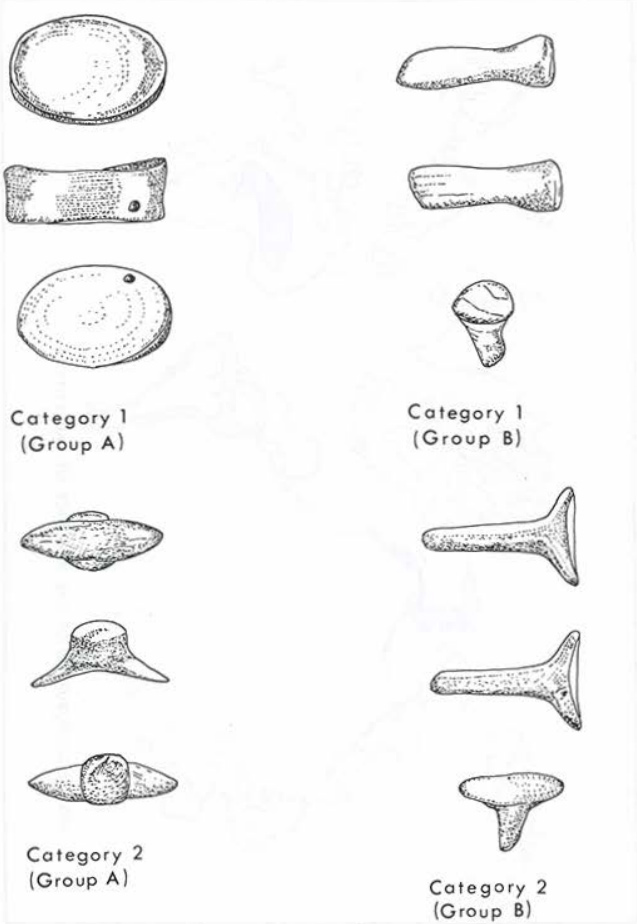
The two main categories presented here can be used to describe all labrets. Groups unique to specific regions, such as the double bodied lateral labrets from the Gulf of Georgia or the double bodied medial labrets from parts of southwest Alaska could be tentatively categorized pending a larger sample and further investigation. However, for present purposes even these labrets can be described in relation to the morphological templates of the main categories.
As the flange of a labret is actually part of the body, a labret can have only one flange. The conceptual idea of a separate flange and a separate body is evident in composite labrets that have a body that attaches to a flange by means of a groove or pins (Fig. 11). A rare exception to the preceding rule is a labret which has two flanges because it is conceptually two labrets joined in the middle (Fig. 18).
The length of a labret is along the distal-proximal axis and the width is perpendicular to this axis. The proximal end is always the end facing the teeth and the distal end always protrudes out of the lip (Fig. 2).
Category 1: Circular flange labret—the main feature of this category is a flange encircling the proximal end of the body. The word circular does not refer to shape but to the fact that the flange extends beyond the width of the body and extends completely around the proximal end of the body (Fig. 3).
Group 1A: Circular flange short and wide body—These labrets vary greatly in size but generally have an elliptical to round body which is always shorter than the width of the artifact. They are usually constricted between the distal and proximal ends and have a concave flange. Traditionally this type has been referred to in the literature as elliptical or pulley-shaped and may have been worn exclusively as medial labrets.
Group 1B: Circular flange extended and narrow body—These labrets have a body which is narrow and always longer than the width of the artifact. The proximal surface of the flange is usually flat or slightly concave. The body may join the flange at a 90 degree angle or converge into the body.
Category 2: Lateral flange labret—The main feature of this category is a lateral flange which is wider than the body on only two sides. These have been used as either medial or lateral labrets.
Group 2A: Lateral flange short body—The bodies of labrets in this group are short in relation to the longest dimension of the flange. They are often thick and elliptical to round in shape with a concave to convex distal end. The sides of the body are either straight or slightly tapering. They have traditionally been referred to as “plug” or “hat-shaped” labrets.
Group 2B: Lateral flange extended body—The bodies of labrets in this group are long in relation to the longest dimension of their flanges. These labrets are usually thin and straight or slightly tapering. These have traditionally been referred to as “nail” or “T-shaped” labrets.
Distribution of Labrets
Labrets pose some interesting questions in the very nature of their relatively limited world distribution. They occur in four major concentrations (Fig. 5). On the Pacific Rim they occur archaeologically in small numbers from the northern tip of Japan to the Kuril Islands and north to the southern Kamchatka Peninsula. This concentration continues in either an archaeological or ethnographic context in many locations from the westernmost Aleutians to northern Alaska and the Yukon Territory and south to Puget Sound in the State of Washington.
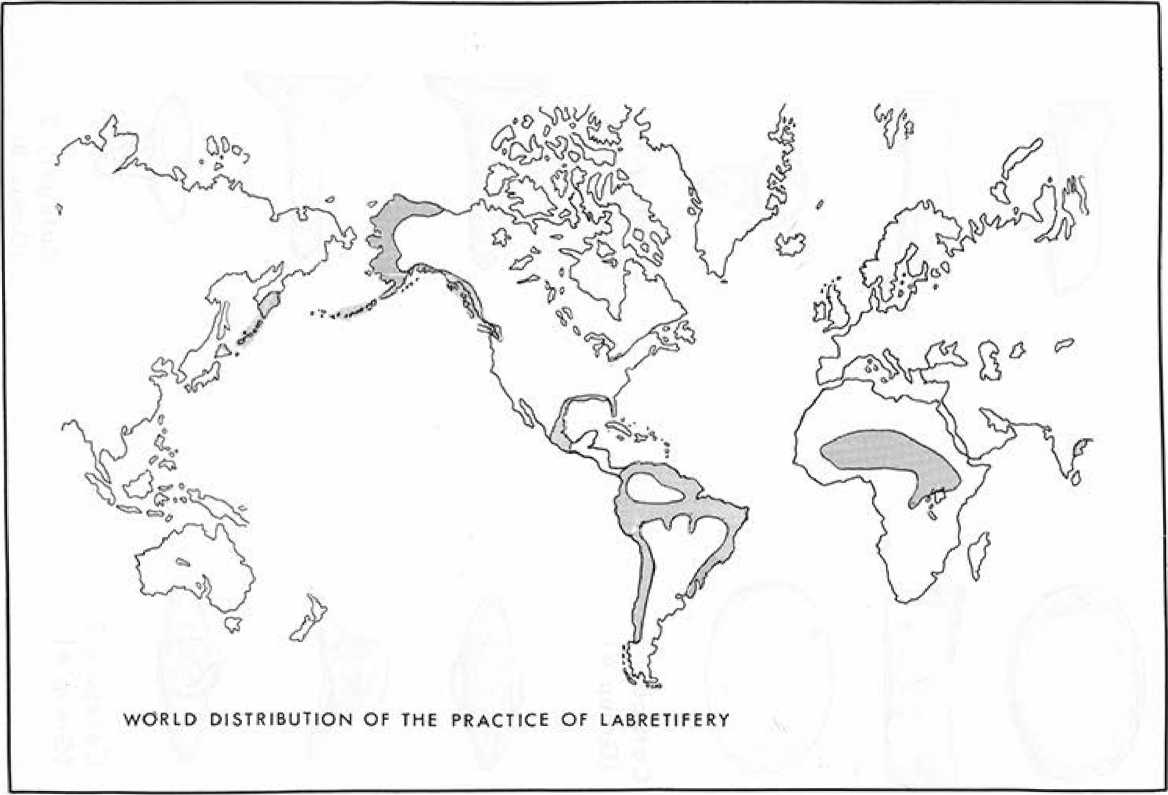
Another concentration occurs over 7 200 km southeast of Puget Sound from the northern Gulf of Mexico through parts of Central America, and then along the Atlantic Coast to Uruguay, through parts of the interior Amazon River basin, and along the Pacific Coast to Southern Chile and bordering areas of Argentina. The third concentration is in Central Africa where they occur in scattered locations between Central Mali and southwestern Ethiopia, extending north to the Central Sudan and south to the Upper Congo River area. The fourth concentration is in India. This paper will focus on the more northern concentration that occurs around the Pacific Rim.
North Pacific Rim Regional Synthesis
North West Coast
At the arrival of non-amerindian peoples in the 1700’s labrets were not worn south of Milbanke Sound (Smith 1906:6). Their occurrence to date south of Milbanke Sound has been restricted mainly to archaeological finds in the Gulf of Georgia region and a few archaeological finds in the area of Bella Bella.
One lateral flange short body specimen has been surface collected from McNaughton Island in the Bella Bella region. Excavations on the same island have produced two ground teeth which may be parts of composite lateral flange labrets (Carlson 1976:113).
Several circular flange labrets may have been found in the Bella Coola region and deposited in the early collections of the American Museum of Natural History. However, the validity of the locations given in the catalogue for the latter are in doubt. Ethnographic accounts among the Bella Coola indicate they were worn only by captured northern slaves or appeared on masks (Mcllwraith 1948:227) or totem poles as representing northern peoples. None have been recovered in archaeological excavations in the historic ethnolinguistic area of the Bella Coola.
North of Milbanke Sound, observations of the wearing of medial circular flange (Fig. 6) and lateral flange labrets among the Tlingit, Haida and Tsimshian are numerous; (e.g., Boas 1916:299, Dawson 1880:108. Dixon 1789:124, La Perouse 1799:165. Lisiansky 1814:224, Portlock 1789:405. Vancouver 1798:468) while a more limited number of ethnographic accounts indicate these labret types were worn also by two northern Kwakiutl groups, the Haisla and Haihais (Drucker 1943:122, 1950:191. 1955:91; Lopatin 1945:19). The latter groups as well as some Babine Carrier (e.g.. HillTout 1907:88, Morice 1904:6) may have adopted the custom in the not too distant past as a result of Tsimshian influence.
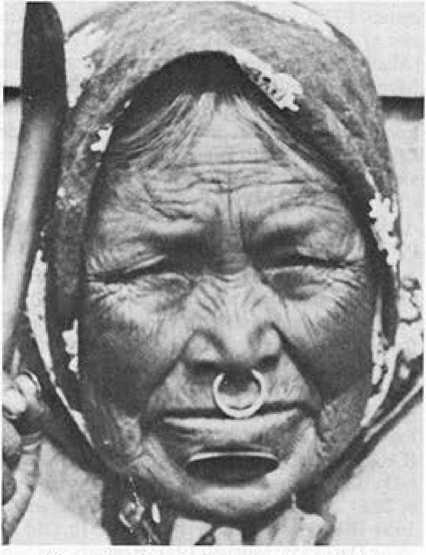
During the post contact period in the northern Northwest Coast cultural area labrets were worn only by women. Archaeological information in the form of labrets in association with burials, labret wear patterns on human teeth not directly associated with labrets, and also the observance of labrets on anthropomorphic artifacts, indicates that they were once worn by both men and women on parts of the northern and southern coast of British Columbia by at least 3,000 years ago (e.g., Cybulski 1974:31. Hall and German 1975:281. Percy 1974:38, Severs 1974:18).
The time of observance is an important factor in historic observations regarding labret wearing. The practice was drastically affected in some areas by early European contact. On the northern Northwest Coast, between the 1840’s and 1870’s, an increasing number of young women stopped having their lips pierced or did not enlarge existing lip holes. Only a few older women continued wearing large labrets into the late nineteenth and early twentieth centuries.
Labrets have been excavated or surface collected in Tsimshian, Haida and Tlingit historic ethnolinguistic areas but only in small numbers. Excavations on Price Island (Simonsen 1973) on the central coast of British Columbia date two circular flange narrow body labrets at c. 2000 B.P. and one to a date later than c. 500 B.P. Three burials with labret dental wear from the Blue Jackets Creek site on the Queen Charlotte Islands (Severs 1974:193) indicate that labrets were worn by both men and women (Inglis pers. comm. 1976) in a period earlier than 2,000 years ago. Since the bilateral buccal abrasion is on the upper and lower premolars and molars and not on the incisors, this may be an indication that the individuals wore two lateral labrets. Varieties of Categories 1 and 2 labrets excavated in the Prince Rupert area date to c. 2500-3000 B P. (Inglis pers. comm. 1975). One Category 2 variety from 16 km east of Terrace dates to c. 300 A.D.-1750 A.D. (Allaire 1968). Circular flange (Group A) stone labrets are recorded from a midden in the Tsimshian area on the Nass River (BCPM Ethnol. Coll.) and from Prince of Wales and Admirably Island (de Laguna 1960. Pl. 10) in the Tlingit area. A unique variety of labret with a sharp point extension below a flat body, and similar to a specimen found on the Alaska Peninsula is from Tenakee on Chichagof Island (Keithahn 1962:75).
In the Gulf of Georgia region labrets appear to have been introduced sometime between 3,500 and 3,000 years ago. Small specimens of the lateral flange extended body type from the Helen Point site on Mayne Island have been dated within this time period (Carlson pers. comm. 1974). Similar specimens from the Glenrose Cannery site on the lower Fraser River date between 2,400 and 2,000 years B.P. (Loy pers. comm. 1976). Lateral flange short body labrets extend throughout the time range from c. 2820 B.P. to a period between c. 2050 and c. 1650 B.P (e.g., Borden 1950a, 1951b. 1951a. 1970: Duff 1955: Mitchell 1971; Haggarty and Sendey 1976). Stone circular flange labrets (Group 1 A), as well as a variety of items which are probably flanges of composite double medial labrets or composite lateral labrets, extend over the time period from c. 2820 B.P. to c. 2150 B.P. Other labret varieties such as double bodied lateral labrets (Fig. 7) and large lateral flange extended and short body varieties (Figs. 8 and 9) are associated with assemblages dating to a similar time spread as the later categories (e.g., Kidd 1971 Pl. VII Russel 1969:5) but have not been found in sufficient numbers to warrant a correlation with these. One of the latter varieties (Fig. 10) may have pierced the lower lip as well as the corners of the mouth to function as both a medial and two lateral labrets.
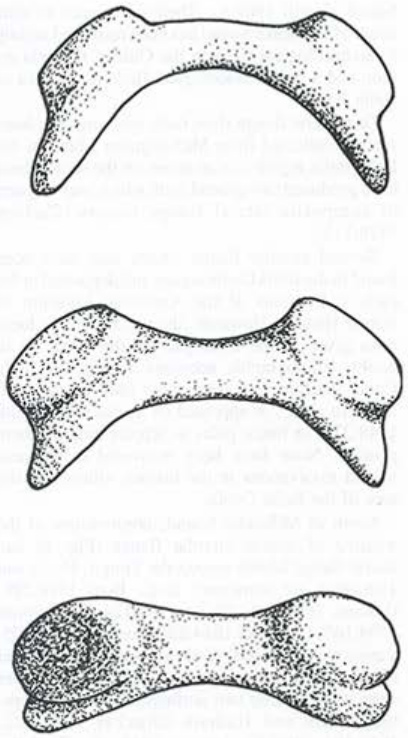
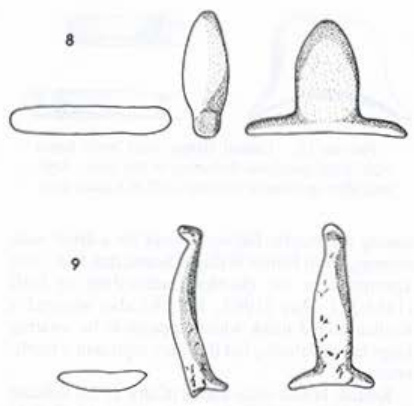
Just outside of the Gulf of Georgia area near Port Alberni, half of what may be a composite circular flange labret with a lap joint and two holes for fastening pins was found associated with a carbon sample dated at c. 2860 B.P. (McMillan and St. Claire 1975:43. Figs. 6a. b). (See Fig. 11 for another example of a composite labret).
Labrets are present in the Fraser Canyon only during the Baldwin phase 3000-2 300 B.P. (Borden 1968:16) and have not been associated with southern assemblages dating within the last 1,500 years. They ceased to be utilized sometime between 1,500 and 2,000 years ago on the southern coast of British Columbia and northwestern Washington.
Gulf of Alaska Area
The Yakutat women were wearing large circular flange labrets in the 1790’s and lateral flanged varieties were most common by the 1880’s. The practice may be a result of the late period Tlingit influence in the area. The early non-Tlingit inhabitants of Yakutat do not appear to have worn labrets as these have not been found in excavations (de Laguna 1972:444), The Denean speaking Eyak did not wear labrets (de Laguna 1964:163).
Between at least 1778 and 1807 the Pacific Yupik speakers, the Chugach of Prince William Sound and the Koniag of Kodiak Island as well as some Athapaskan speaking Tanaina of Cook Intel (e.g., Cook 1784:398, Osgood 193 7:54. Dall 1884:91) wore medial (some were possibly lateral) lateral flange extended body labrets and a lateral flange short or extended flat body variety which often had its distally notched body exposed through either multiple or single lip holes (e.g., Beaglehole 1967, PI. 44, 45; Force and Force 1968:156). The distal extensions had perforations for the attachment of hanging beads although the labrets were generally worn without beads (Fig. 12). The women and boys had multiple perforations, usually two to six, while older men had a single large slit (e.g., Davydov in Bearne and Pierce 1976:2-3, Lisianski 1814:165. Meares 1790: Figs 4 and 9).
Historic observations are often inadequate and later misinterpreted because of the change in the number of lip holes with the age and sex of the wearer as well as due to an unawareness of the unique design of some labrets such as that shown in Figure 10. When worn, the latter variety gives the observer the impression that several separate labrets are being worn when in fact the protruding bodies are parts of a single labret that protrudes through separate lip holes. Misinterpretations also arise because of the drastic effect on the practice of labret wearing due to Russian contact in the area. On Kodiak Island the labret was universal in 1780 but was rarely worn after 1805 (e g., Langsdorff 1817:114. Lisianski 1814:195).
In an archaeological context the small lateral flange extended round body variety is found with assemblages (de laguna 1934) dating between c. 1369-2706 B.P. from Cook Inlet. The Palugvik site (de Laguna 1956:205) in Prince William Sound places this variety in the early second millennium B.P. In Cook Intel (de Laguna 1934:110) during approximately the same period, or up to 500 years earlier, the Yukon Island II deposits revealed a male burial that was found with a medial lateral flange short body labret that has a wide body. A carving from the same deposits, believed to represent a male, has a large single medial labret (de Laguna 1934 Pl. 52-2c). Another undated carving of a man from nearby Kasitsna Bay has three medial labret holes (de Laguna 1934:52-7).
The lateral flange short or extended flat body variety (Fig. 13) observed in post contact times is associated with a child and an adult male burial in Yukon Island deposits (de Laguna 1934:110) dating to c. 1369 B.P. Large circular flange (Group 1A) labrets, similar to those of the historic Tlingit were also associated with the latter deposits. One of these was a complete composite circular flange labret associated with a woman’s burial. Thu specimen has a tenon and socket joint with a single fastening pin. A burial of a middle-aged female from the Cottonwood Creek Site was found with two large lateral labrets. The burial dates within the last 1,800 years B.P. (de Laguna 1975:1V, King 1976:215), This is the only record of lateral labrets being worn among the Pacific Eskimo except for a dried male mummy from Prince William Sound that had “two apertures in the checks” according to Dall (1884:32). Ray (1967. Pl. 68) also showed a Kodiak Island mask which appears to be wearing large lateral labrets, but this may represent a northerner.
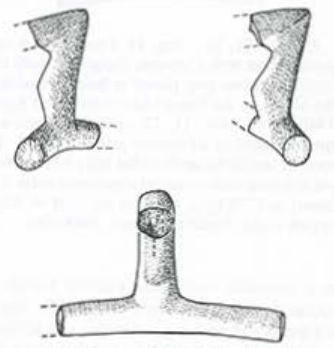


Kodiak Island excavations (Clark 1970) indicate that the lateral flange short and extended body labrets date between c. 2100 and 1000 B.P. The latter category includes the varieties with the flat body as well as those with the rounded and the extra wide body. Those with the extra wide body have a proximally directed flange. The narrow extended body variety is associated with the later date. A distinct variety has a flattened wide lateral flange with a constricted short circular body, the distal surface of which is concave. These are associated with the later half of the previously mentioned time sequence, i.e., 1500-1000 B.P.
The Aleutian Islands
In the mid to late 1700’s labrets were worn by both Aleut men and women, (e.g., Bushnell 1928, Sauer 1802:15, Webber in Beaglehole 1967, Pl. 52a, b) although they were most common among women (Cook 1784:509). Only a small percentage of men wore them. Men wore both the small medial lateral flange, short. round body and the short, wide body varieties. Women wore small lateral flange extended or short body specimens as single and double medial labrets. Sarychef (1807:16) shows a variety of medial labrets that resemble curved unilaterally barbed points.
Excavations on Umnak Island revealed very wide (i.e., 150 mm) lateral flange labrets (Fig. 15) dating between c. 1400 B.P. and c. 300 B.P. (Aigner 1966:63). These are similar to a variety found attached to some large late pre-contact burial masks (e.g., Dall 187 7:87. Jochelson 1925:100). Some of these would appear to be too large to be worn in the mouth. However, that it is possible is shown by the example in Figure 14. The mouth has been stretched beyond 150 mm by some African women who wore circular flange labrets more than 230 mm in diameter or the size of an average English dinner plate. The large Umnak variety was previously found on Atka (Jochelson 1925, Fig. 89) and Amaknak Island in an undated context.
Lateral flange extended and short thin body specimens from Umnak Island span the period from c. 3200 B.P. to c. 300 B.P., with one specimen (the earliest in the Aleutians) dating to c. 4000 B.P. (see Aigner 19 66:64, 1978:20). These have been found in the Rat and Near Island groups dating from approximately 3000 to 1000 B.P, (e.g., McCartney 1971. Turner 1970). Few circular flange (Group 1A) labrets have been found in the Aleutians. This category has been recovered from a late precontact or early contact period at Amaknak cave on Unalaska Island (Dall 1884:6, Fig. 3, 4), from an undated midden on Amchitka Island (Turner 1970), and also found over 3 m below the surface in an undated Umnak Island midden (Jochelson 1925:96).
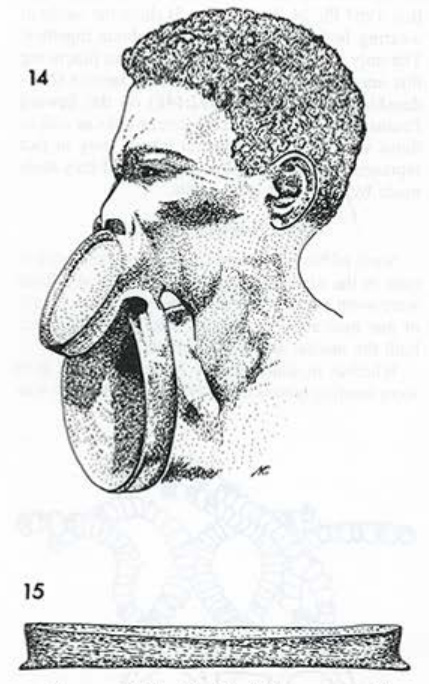
Southwestern Alaska
Some diversity exists with regard to the practice of labretifery among the Yupik speakers of southwestern Alaska. In general labrets were commonly, but not universally, worn by men and were worn by a minority of the women (e.g., Dall 1884:91. Nelson 1899:45). It is interesting to note that only men wore labrets among the northern Unaligmuit (Oswalt 1967:199) who were on the boundary between Yupik and Inupik speakers. Among the latter peoples labrets were restricted to men. Some Ingalik on the lower Yukon adopted labret wearing but the custom was practiced only by those Ingalik who traded with the Coastal Inupik.
A distinct variety of women’s labret was worn in the latter half of the 18th century on Nunivak Island and the adjacent mainland to the Yukon Delta area. Although these varied in style, the common variety was like a small lateral flange extended body labret with the body curved into a J or C shape (Nelson 1899:45, Ray 1967. Pl. IV). These were worn in one or two (occasionally several) medial lip slits (Figs. 16 and 17).
One double medial variety has a cross-bar centrally joining two J-shaped bodies (e.g., Nelson 1899, Pl. XXII, Fig. 1). This variety is composite in that it has a small flange attached to each body (Fig. 18). In other parts of southwestern Alaska the lateral flange variety with a straight extended body was worn by some women.
Men’s labrets included the flange varieties with short and extended bodies. Some of these had a hole drilled longitudinally through the body. A pin would extend through and beyond the distal end and have a stone or bead attached to it (Fig. 19). This same variety was also found among Inupik speakers throughout parts of coastal Northwestern Alaska (e.g., Nelson 1899 Pl. XXH. Simpson 1875:239-40). Some of the most elaborate composite labrets come from Nunivak Island but it is not known in many cases by which sex they were worn. One variety has a stone carved in the shape of a whale’s tail-fin, attached by a tenon and socket joint and fastening pin to a small lateral flange labret. This variety was also once used on King Island (Fig. 20) off the Seward Peninsula.
One good source of information on labret styles in southwestern Alaska may come from masks that portray labret wearers. The reliability of masks to portray realistically the labret styles in various regions depends on the available information regarding the mask. A mask from one locality may be intended to represent the appearance of other peoples or in some cases may have been made by non-indigenous peoples such as is the case in the St. Michael area (Edmonds 1966:111) where masks and labrets were made principally by Malemiut who came from the north in the early part of the nineteenth century. Another difficulty is the possibility of mistaking a variety of other features for labrets, such as the pegs for holding helmets that are associated with some masks.
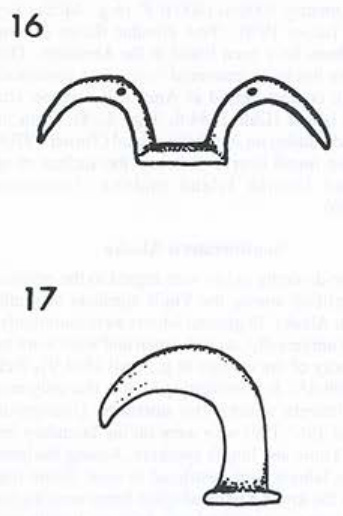
A study of masks from southwestern Alaska reveals some labret wearing practices that are reflective of both the modes practised in the early-contact period as well as modes not observed in the early contact period. Most masks confirm the use of the varieties existing in the later half of the nineteenth century. Other masks reveal that some men practised the lateral mode, and two masks (one from Sabotnisky on the lower Yukon River and one from St. Michael on the south shore of Notion Sound. Ray 1967 Pl. 24. p. 156 Fig. 3) show the mode of wearing both medial and lateral labrets together. The only reported observation of a man practicing this uncommon mode is from Port Clarence (Nordenskiold in Murdock 1892:148) on the Seward Peninsula. It is likely that the latter masks as well as those with only double lateral labrets may in fact represent northern peoples, especially if they were made by Makmiut immigrants.
Northwestern Alaska
North of Norton Sound labrets were restricted to men in the ninteenth century. Only lateral labrets were worn except in the previously mentioned case of one man at Port Clarence who had lip slits for both the medial and lateral labrets.
Whereas in southwestern Alaska only old men were wearing labrets in the 1890’s, the practice was still prevalent among men of all age groups in northern Alaska at this time. A few elderly men with lip slits were observed in this area as late as the 1940’s.
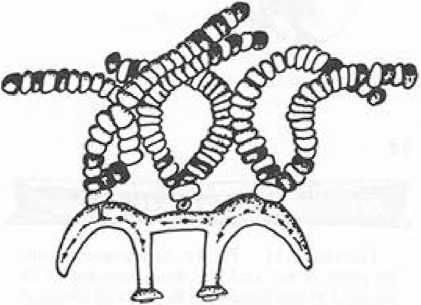
Labrets were worn in northern Alaska only after puberty, as the lips are not pierced prior to that period. However, an irregularity existed with regard to the age at which the lip was perforated in boys. A boy was entitled to have the operation performed as soon as he had killed a deer, wolf or seal; which was also the necessary prerequisite before one was allowed sexual intercourse. Some, after meeting these conditions, submit to lip piercing early while others delay it (Simpson 1875:140).
The ceremony involved the piercing of the lip in both corners of the mouth with a small lancet of slate (Murdock 1892:114). After the incision was made, a long, thin labret was thrust through. Gradually the hole was enlarged by a series of small labrets which afterward were strung on a sinew cord. These were hung as a pendant to the end of the wife’s waist belt or to the strap of her needle case (Nelson 1899:48).
The eastern limit of the wearing of labrets was once thought to be the mouth of the Colville River (Dall 1884:92). It was believed that labrets spread East of the Colville River region to Cape Bathhurst after the 1840’s (e.g., de Laguna 1934:204. Murdoch 1892:127. Osborne 1952:36). Recent excavations, however, place labrets in the Mackenzie Delta (McGhee 1971:38) in al least a pre-600 B.P. context and possibly as early as 2000 B.P.
The Taremiut of Point Barrow were observed in 1826 wearing large labrets with distal-proximal flattening of the body (Fig. 21). It was not noted at the time whether the mode of wearing these labrets was lateral or medial (Elson in Murdoch 1892:147). However, similar labrets to those observed in 1826 were being worn as amulets on the belts of their owners in the 1880’s and traditional stories at that time indicated these were once worn as single medial labrets (Murdoch 1892:143).
In northern Alaska several basic but variable groups of labrets were worn. The most common group was the lateral flange short body labret which occurred in a variety of styles. In some cases the styles are regional and in other cases they represent specific time periods.
One practice common from at least c. 1816 to the 1880’s in central western Alaska was the wearing of a lateral flange short body labret with distal- proximal flattening (e.g., Nelson 1899. Pl. 23). This style was commonly ornamented with half of a blue glass trade bead (Fig. 22).
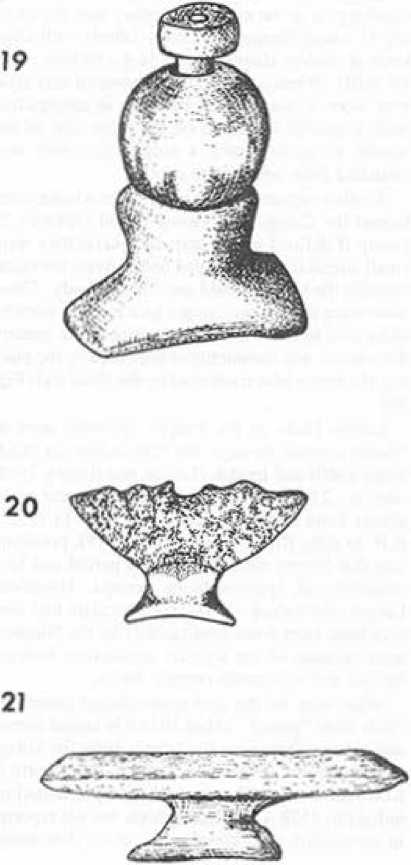
A style common to the Cape Prince of Wales-Icy Cape region in the nineteenth century was the wearing of lateral flange short body labrets with large knob or convex shaped bodies (e.g., Nelson 1899, Pl. XIII). When a large lateral labret of this style was worn it would often be worn in conjunction with a smaller specimen on the other side of the mouth or occasionally a single specimen was switched from one side to another.
Another common group in northern Alaska overlapped the Category 1, Group B and Category 2, Group B defined in this text In general they were small lateral flange extended body labrets but occasionally the flange would encircle the body. These were worn mainly by younger men but also worn by older men in some areas. In the nineteenth century this variety was commonly ornamented by the placing of a whole blue trade bead on the distal end (Fig. 19).
Labret finds in the Inupik speaking area of Alaska extend through the Choris-Norton (Giddings 1960) and Ipiutak (Larsen and Rainey 1948) sites (c. 2700 B.P. to c. 1400) but appear to be absent from approximately 1400 B.P. to c. 372 B.P. to date, Birket Smith’s (1953:218), presumption that labrets were absent for a period and later reintroduced appears to be correct. However, Larsen and Rainey (1948:116) speculate that they may have been worn continuously by the Nunatarmiut because of the stylistic similarities between Ipiutak and nineteenth century forms.
What may be the first reintroduced labrets include both “paired” (Hall 1971:43) lateral labrets and circular flange medial labrets from the village of Noatagmiut on the lower Noatak River north of Kotzebue Sound. The site is dated by dendrochronology to 1578 A.D. These labrets are not reported in association with burials so it is not determined whether the two categories of labrets were worn separately or together. Labrets were commonly worn by Ipiutak peoples (c. 1900 B.P.-c. 1400 B.P.) as indicated by their occurrence on most representations of human faces. Two mask-like ivory carvings and two carvings of human faces have lateral labrets while at least two schematic faces with labrets or labret slits appear on antler tubes (Larsen and Rainey 1948:25, 54, 55). Two of these show the single medial mode while eight show the lateral mode of wearing a labret. An alternative explanation of the schematic markings is that they represent facial tattooing. There is a correlation in the placing of some tattoos and labrets. This could be a confusing factor especially in the case of the Asiatic Eskimo and the Maritime Chukchi among who both sexes have concentric circles near the corner of the mouth where lateral labrets were worn by the men of northwestern Alaska.
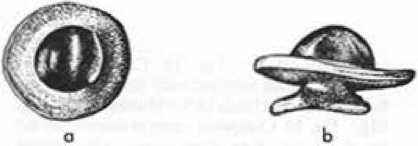
More information is needed on the association of labrets with skeletons at Ipiutak sites before any definite conclusion can be made about the modes of labret wearing practised. Two large lateral flanged labrets with distal-proximal flattening of the body were found with the skeleton of a 15-year-old girl at Ipiutak, but this does not necessarily imply that they were worn by the girl. In the historic period labrets were known to be kept by relatives of a deceased person (Stephansson 1914:152, 193) and passed on through the family line. It may be that the large labrets associated with the Ipiutak burial once belonged to a relative of the girl (Larsen and Rainey 1948:114) and were buried with her to assure that she obtained a higher status in the after life.
The Chukchi Peninsula
Labrets do not appear to have been worn on the Chukchi Peninsula with the exception of intrusions in the eighteenth and nineteenth centuries and were not worn on St. Lawrence Island.
Krasheninnikov (1972:70) refers to “natives of the island near Cape Chukotsk” who “insert bones into their faces”. The objects he describes as “small sea horse teeth” are probably dentilium shells used as nose ornaments and not labrets. This would tend to be confirmed by Dall’s (1877:103) informant from the same area (Plover Bay), who stated that the people of that area came “long ago” from the Diomedes because there was war between them and the people who wore labrets. As Dall indicates, this conflict between non-labret wearers west of the Bering Strait and labret wearers east of the Bering Strait is supported by the experiences of Deshneff in 1648, Popoff in 1711, and Shestakoff in 1730.
Nelson’s report of seeing a few people with labret holes at Mechigmen Bay (on the cast side of the Bering Strait) between 1877 and 1881 (Nelson 1899:45) is a result of the earlier transplanting of peoples to this area from the east.
Other than the possibility of a few difficult to interpret facial markings on anthropomorphic figurines, there is no conclusive evidence to date of labrets in a prehistoric context on the Chukchi Peninsula. It is possible, however, that some of the objects described by informants as seal float plugs may be labrets, as informants in this area would be unfamiliar with labrets if they were abandoned at an early time period.
Cheek labrets are present on an Okvik facial carving according to Arutyunov, Levin and Sergeyev (1964:343. Fig. 5), but these circles with crossing lines inside in fact appear to represent tattoo marks. Nelson (1899:52. Fig. 15) shows a tattoo mark on a man from Mcchigme Bay identical to that on the Okvik facial carving.
The Kamchatka Peninsula
Labrets occur on the southern Kamchatka Peninsula but their temporal context is uncertain. Jochelson (1925:96) found a labret near Petropovlovsk. just north of Avatcha Bay. where another labret was found associated with the Avatcha complex. This undated complex, which among other things is characterized by the introduction of pottery of the Kuril Lake Plain type, oval stone lamps and polished celts, is believed to be oriented toward the ancient Ainu of the Kuril Island chain (Quimby- 1946: 177-78). The Avatcha complex is similar to the second level of the more northerly Ushki site on the Kamchatka River and may date to the same period.
Dikov (1965:13) dates the second level at Ushki to the second millennium B.C. The dating of this level is based on generalized inferences from stratigraphic and palynological data. The exact dating of this level, and where the labrets occur in it, is crucial in determining the origin of labrets on the Pacific Rim. Dikov (1965:13) gives the labret importance as an indicator of the direction of cultural movement from west to east. If the Ushki labrets date from the first half of the second millennium B.C. he may be correct, but if they date to the latter half of the second millennium a movement from cast to west is also possible.
Since labrets were not worn by the ethnographically described Kamchadals, credence is given to the belief that labrets are part of an early complex that extended from the south. Rudenko (1964:292) indicates that the Kamchadals may have been culturally dominated by the mixing of Kuriles or Ainus before the first millennium A.D. The Kurile Islands or Japan would be likely sources of the labret, if labrets were introduced to Kamchatka from an area west of the Bering Strait. This is indicated both by the fact that labrets are not known to exist in the Okhotsk Sea area and that labrets were introduced at the same time as pottery which may have its origins to the south. There is however no evidence of a labret wearing culture moving from the south to the Kamchatka Peninsula. The opposite is in fact the case.
The Kuril Islands
Befu and Chard (1964:10) in their reporting of Japanese sources indicate that labrets have been found on at least two of the Kuril Islands that extend between Japan and the Kamchatka Peninsula. Those found on Paramushir Island are attributed by Baba to the late relocation of aleuts in the area by Russians (c. 1790 A.D.-1826 A.D.). Those found on Shumshu Island are attributed by Kodama to a more “ancient” time period.
Japan
The information regarding labrets in Japan is sparse. “Labret like” objects found at Moyoro on northern Hakkaido are reported by Befu and Chard (1964). The descriptions of these would appear to include both Category 1 and Category 2 labrets. The Moyoro aspect of the Okhotsk cultural assemblage with which these Japanese labrets are associated dates to c. 1000 B.P. This recent labret associated culture has moved south from the Kurile Islands (T. Kobayashi 1978. pers. comm.).
Dall (1877:88) refers to an “ancient caned wooden button, covered with grotesque heads” purchased in Japan. One of the heads had two lateral ivory labrets. This item was possibly a recent northern trade good. Munro (1911) points to incisions at the comer of the mouths on pottery figures as possibly representing labrets. These incisions first appear c. 5000 to 4000 B.P. in the middle Jomon period (see Kidder 1966:61. Fig. 10). These marks probably represent tattoo marks as labrets have not been found in Jomon assemblages.
Summary of the Temporal-Spatial Context and Sexual Differences in the Practice of Labretifery
The two main categories of labrets, noted here, have a wide spacial distribution. In some areas that have been archaeologically tested one or more of the four groups persist over a considerable time period. Specific differences in style are sometimes restricted to particular regions or to particular time periods.
In a period extending from between 4,000 and 3,000 years ago until the historic period, the distribution of the practice of labretifery on the North Pacific rim waned from a Washington State to northern Japan distribution range to a range excluding the southern coast of British Columbia and areas west of the Bering Strait (Fig. 23).
Labrets appear on the west side of the Bering Sea in Kamchatka sometime between 4,000 and 3,000 years ago. They are associated with a culture that extended south in a later time period from the Kuril Islands, to the northern end of Hokkaido Island. This culture was later (c. 1000 A.D.) dominated by outside influences, thus bringing an end to the practice of labretifery west of the Bering Strait until a brief historic reintroduction as a result of Russian trading activity.
Labrets appear in the Aleutians sometime just prior to 4000 B.P. and appear in northwestern Alaska associated with the Norton culture at c. 2700 B.P. Both men and women wore labrets in the Aleutians but they were much more common among women in historic times. The reverse is true for southwestern Alaska, labrets being more commonly worn by men.
It is noteworthy that labrets were worn by both sexes in northwestern Alaska prior to their disappearance during the spread of the Birnirk culture from c. 500 A.D. to 900 A.D. or later, and were worn only by men when they were reintroduced.
Labrets were present in southwestern Alaska and the Gulf of Alaska area by at least 2800 B.P. By historic times the variability and complexity of styles became pronounced in Southwestern Alaska with some distinction being possible between “women’s labrets” and “men’s labrets”. Modes of wearing labrets included single and double medial and lateral, as well as a combination of single medial and lateral in a minority of cases.
In historic times, in the Gulf of Alaska area, Pacific eskimo women and boys had multi-medial perforations for one or several medial labrets, while older men had one large slit for a single medial labret. This pattern appears to be more complex in the archaeological record with at least some women wearing large medial as well as large lateral labrets and possibly some men wearing lateral labrets as well.
On the Northwest Coast, labrets appear sometime between 3500 and 3000 B.P. They ceased to be worn on the southern coast of British Columbia between 2,000 and 1,500 years ago. Previous to this time period they were worn by both men and women in the Gulf of Georgia area as well as on the northern coast in the area of Prince Rupert and the Queen Charlotte Islands. Why they disappeared altogether in the Gulf of Georgia area and why they were being worn only by women on the northern Northwest Coast in historic times is still unexplained.
Conclusions
Henry Rink (1888) was the first to claim that harsh environmental factors prevented the spread of labrets across northern Canada and Greenland. However, the northern labret wearing Inupik speakers adapted to this problem of lip freezing by removing their labrets when travelling and reinserting them when entering a village (e.g., Nelson 1899:50). The failure of labrets to spread across Northern Canada and Greenland is best explained by Taylor’s (1963:456) hypothesis that the Canadian Thule evolved from offshoots of the Birnirk culture, which had by 1100 B.P. extended as far east as Cape Perry on Amundsen Gulf. The Birnirk culture, which lacked labrets, appears to be a product of strong influence from the non-labret wearing areas on the Chukchi Peninsula. This influence is probably the result of intensive trade in new metal goods and subsequent assimilation and population movements.
Evidence to date indicates that the practice of labretifery has approximately a 4,000-year history on the Pacific Rim. A general similarity in several styles existed from an early period with additional regional specializations also developing early.
A number of authors have commented on the direction of the diffusion of labrets. Most have assumed that labrets are typical “Eskimoid” artifacts, or obvious products of “Asiatic influence”. Although de Laguna (1934:206) indicated that “as far as the Eskimo are concerned the labret came to them from the south”, and Collins (1937:376) has postulated that the line of diffusion was from east to west by way of the Aleutians, the possibility that labrets originated on the southern Northwest Coast was net seriously considered until Borden (1962:13) armed with (then) early dates, pointed out that “Eskimo-Aleut very likely adopted the practice of wearing lip ornaments from early Northwest Coast Indians”.
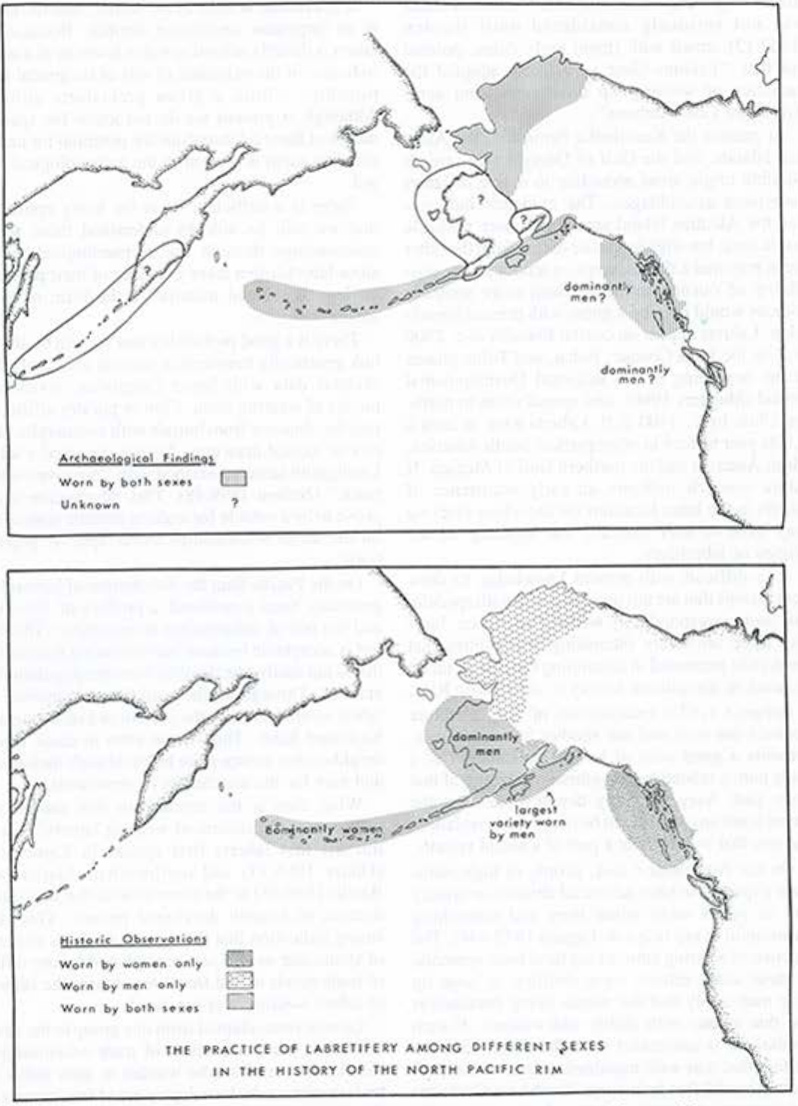
At present the Kamchatka Peninsula, the Aleutian Islands, and the Gulf of Georgia area, are all possible origin areas according to dating of labret associated assemblages. The evidence indicates that the Aleutian Island area is the more probable origin area, but slightly earlier dating from the other areas may make this assumption tenuous. The possibility of outside influence from more southern sources would only be a guess with present knowledge. Labrets appear on coastal Ecuador at c. 2500 B.P. in the Jama Coaque, Bahai, and Tolita phases at the beginning of the Regional Developmental Period (Meggers 1966), and spread south to northern Chile by c. 1400 B.P. Labrets have at least a 2,000-year history in other parts of South America, Meso America and the northern Gulf of Mexico. If future research indicates an early occurrence of labrets in the latter locations (or anywhere else) we may have to alter radically our thinking on the origins of labretifery.
It is difficult with present knowledge to draw conclusions that are not overburdened with speculation and correspondingly weak in substance, but I feel there are many interesting possibilities that need to be presented in examining the role of labret wearing in the cultural history of the Pacific Rim.
Seeger’s (1975) examination of why a culture chooses one item and not another for its symbols, presents a good case of how ornamentation of a body part is related to the symbolic meaning of that body part. Seeger’s study demonstrates that the labret is not an ornament to be observed in isolation, but one that is definitely a part of a social system.
On the Northwest Coast, people of high status were expected to have advanced abilities in oratory and to speak only when they had something meaningful to say (e.g., de Laguna 1972:444). The practice of wearing labrets may have been symbolic of these status related vocal abilities. A large lip plug may imply that the mouth being stretched is one that speaks with ability and wisdom. If such symbolism is associated with the labret, it is an artifact that was well ingrained as part of the conceptual world that held some Northwest Coast social systems together and therefore needs to be examined from that perspective.
It is evident, at least to the author, that the labret is an important socializing symbol. Because the labret is directly related to status it serves as a stable indicator of the existence of sets of reciprocal relationships within a given prehistoric culture. Although at present we do not know the specific nature of these relationships the potential for understanding them is present in the archaeological record.
There is a sufficient basis for being optimistic that we will be able to understand these social relationships through the archaeological record since labrets often leave evidence of their presence on human skeletal material in the form of tooth wear.
There is a good probability that we will be able to link genetically transferable skeletal traits and other skeletal data with labret categories, styles and modes of wearing them. Clan or phratry affiliation may be obtained from burials with zoomorphic labrets or incised drawings. Nelson observed a set of Unaligmiut labrets inscribed with “the raven totem mark” (Nelson 1899:48). This information could prove to be a vehicle for making definite statements on the social relationships within specific populations.
On the Pacific Rim the distribution of labrets has generally been considered a product of diffusion and not one of independent development. This belief is acceptable because labret wearing is a custom that is not easily transferable from one population to another. Throughout the world the neighbours of labret wearers look on the custom as a revolting and backward habit. This is true even in cases where neighbouring groups poke holes through their noses and ears for the attachment of ornaments.
What then is the mechanism that caused the diffusion of the custom of wearing labrets? It is of interest that labrets first appear in Kamchatka (Dikov 1965:13) and northwestern Alaska (see Bandi: 1969:65) at the same time as the first introduction of already developed pottery. This is a strong indication that the spread of labrets as items of status and wealth was precipitated by the influx of trade goods to and from areas where the custom of labret wearing was practised.
Labrets were adapted from one group to the next, at least in part, as a result of trade relationships. Non-labret wearers who wanted to gain status as trading partners had to adopt some of the customs of the dominant trading partners. The labret probably was the most visual evidence of status and the wearing of them was a necessity to be readily accepted as a trading partner.
It was likely these outside traders, who through their own wealth, gained high status among their own people. Being people of high status their newly adopted custom of labret wearing begun to be emulated by their own people. The process would be more rapid as a result of intermarriage between trading parties.
This suggestion as the basis for the spread of labrets is substantiated by the fact that this very process was occurring in the late prehistoric and early historic period between coastal labret wearers and Interior peoples who were non-labret wearers. Small numbers of Athapaskan speaking Tanaina, Ingalik, and Babine Carrier who were involved in intensive trade relations adapted the custom from their respective dominant trading partners.
One of the casual factors in this system of wealth distribution was likely an intensification of the two way flow of trade goods across the Bering Strait and a subsequent intensification in trade north-south along the coast and east-west from the coast to the Interior.
The appearance of labrets throughout the north Pacific Rim was rapid, possibly occurring within a period of only 500 years or less. The spread of labrets from Peru to northern Chile, which involved the actual movement of people, took twice as long.
The distribution of labrets represents an expansion in the importance of status and possibly wealth and the maintenance of a class structure.
Areas where labrets first appear on the Northwest Coast such as the lower Skeena River, the Queen Charlotte Islands and the Gulf of Georgia area were possibly major trading spheres of what may have been a broad reaching trading system that extended around the Pacific Rim before at least 3,000 years ago.
The labret-bearing Baldwin phase in the Fraser Canyon which began 3000 B.P. may represent one of the outer boundaries of the southern most trade distribution system. Borden’s (1968:16) comments on the Baldwin phase are of some insight here:
“The interaction of local cultural tradition with widely varied alien influences during this period appears to have generated a cultural efflorescence which is reflected in many remarkable non utilitarian artifacts. The cultural efflorescence of the Baldwin phase seems to have come to an abrupt end in the canyon sometime in the fourth century B.C.”
This abrupt end of the Baldwin phase may be the result of the first shrinking of a trading network. The disappearance of labrets from the entire Gulf of Georgia area occurred rapidly at the same time as the disappearance of a microblade technology. The latter technology depended on long distance trade for much of its raw materials.
Labrets are much more than simple ornaments. With more accurate recording of labrets there is a strong chance that they may contribute considerably to our understanding of the cultural history of the North Pacific Rim.
Thanks are given to Nancy I. Condrashoff for the production of all drawings in the text and to Donald N. Abbott, James C. Haggarty, Thomas H. Loy. and S. Gay Calvert for their criticisms of an earlier manuscript, and to Elaine Patterson for typing several versions including the final copy. Any errors of fact or overspeculation are, of course, the fault of the author.
Ackerman. R E. 1964. Prehistory in the Kuskokwim-Bristol Bay Region. Southwestern Alaska. Lab. Anthropol. Rep. Invest, No. 26. Washington State Univ., Pullman 48 pp.
Aigner, J.S. 1966. Bone tools and decorative motifs from Chaluka, Umnak Island. Arct. Anihropol, 3(2):57-83.
1978. Activity zonation in a 4,000-year- old Aleut house, Chaluka Village. Umnak Island. Alaska, Anthropol, Pap. Univ. Alaska. 19:11-27.
Allaire, L. 1969. The cultural sequence of Gitaus: A case of prehistoric acculturations, in R. Inglis and G. MacDonald eds., Skeena River Prehistory. Nat. Mus. Man (Ottawa), Mercury Scries 87:21-52.
Arutyunov. S. A., S. A. Levin, and A. A. Sergeyev. 1964. Ancient burials on the Chukchi Peninsula, in H. N. Michael, ed., The archaeology and geomorphology of northern Asia: Selected works. Arct. Inst. of North Am., Anthropol. of the North. Transl. from Russian Sources. No. 5, Univ, of Toronto Press, pp. 333-346.
Bandi, H, G. 1969. Eskimo prehistory. Univ. Alaska Press, Fairbanks 226 pp.
Beaciukuje. J C., ed. 1967. The journals of Captain James Cook on his voyages of discovery. Vol. 3. The voyage of the Resolution and Discovery, 1776-80, Pt. 1. Publ. for The Hakluyt Society by Cambridge Univ. Press. Cambridge. 536 pp.
Bearne. C., transl., and R. A. Pierce, ed. 1976. A selection from G. I. Davydov: An account of two voyages to America. Arct. Anthropol. 13(2):1-30.
Befu, H., and C. S. Chard. 1964. A prehistoric maritime culture of the Okhotsk Sea. Am. Antiq. 30:1-18.
Birket-Smith. K. 1953. The Chugach Eskimo, Nat. Mus. Skr. Elhnol. Raekke. 6. Copenhagen. 270pp.
Boas, F. 1916. Tsimshian mythology. Smithson. Inst. Bur. Ethnol., Annu. Rep. 31:29-1037.
Borden. C. C. 1950. Preliminary report on archaeological investigations in the Fraser Delta Region. Anthropol. in B.C. 1:13-26.
1951a. Facts and problems of northwest coast prehistory. Anthropol. in B.C. 2:35 -49.
1951b. Fraser River Delta archaeological Findings. Am. Antiq. 16:263.
1962. West Coast crossties with Alaska, in J. Campbell, ed., Prehistoric cultural relations between the arctic and temperate zones of North America. Arct. Inst. North Am., Tech. Pap. 11:9-19.
1968. Prehistory of the lower mainland, in A. H. Siemens, ed., Lower Fraser Valley: evolution of a cultural landscape. B.C. Geogr. Ser. 9. Univ. of B.C. Vancouver, 9-26 pp.
1970. Cultural history of the Fraser-Delta region: an outline, in R. L. Carlson, ed., Archaeology in British Columbia: new discoveries. B.C. Studies (Spec. Issue) 6-7:95-112.
Bushnell. (Jr.) D. I. 1928. Drawings by John Webber of natives of the Northwest Coast of America, 1778. Smithson. Misc. Collect. 80(10):1-12.
Carlson. R. L., 1976. The 1974 excavations at McNaughton Island: Current research reports. Dep. Archacol. Pub. No. 3, Simon Fraser Univ. 99-114 pp.
Clark, D. W. 1966. Prospectives in the prehistory of Kodiak Island, Alaska. Am. Antiq. 31:358-371.
1970. The late Kachemack tradition at Three Saints and Craigpoint, Kodiak Island. Alaska. Arct. Anthropol. 6:72-111.
Collins, H. B. 1937. Archaeology of St. Lawrence Island, Alaska. Smithson. Inst, Misc. Coll. 96(1):1-431.
Cook. J. 1784. A Voyage to the Pacific Ocean, undertaken by the command of His Majesty performed under the direction of Captains Cook, Clerke and Gore, in His Majesty’s Ships, the Resolution and Discovery. in the years 1776, 1777, 1778. 1779 tod 1780. Vol. 2. Printed by W. & A. Strahan for G. Nicol and T. Cadell, London.
Cyuuuki. J. S. 1974. Tooth wear and material culture: Precontact patterns in the Tsimshian area, British Columbia. Syesis 7:31-35.
Dall. W. H. 1884. On masks, labrets, and certain aboriginal customs, with an inquiry into the bearing of their geographical distribution. U.S. Bur. Ethnol. Third Annu. Rep., (1881-82. pp. 137-143.)
1887. On succession in the shell-heaps of the Aleutian Islands, in tribes on the Extreme Northwest. Contrib. North Am. Ethnol. 1:41-91.
Dawson. G. M. 1880. Rep. of progress for 1878-79. Dom. Geol. Surv. Montreal. 17-94 pp.
Dikov. N. N. 1965. The stone age of Kamchatka and the Chukchi Peninsula in the light of new archaeological data. Arct. Anthropol. 3(1): 10-25.
Dixon. G. 1789. A voyage round the world; but more particularly to the Northwest Coast of America: Performed in 1785, 1786, 1787, and 1788 in the King George and Queen Charlotte. G. Goulding. London. 360 pp.
Drucker. P. 1943. An archaeological survey on the northern northwest coast. Anthropol. Paper No. 20. Bur. Am. Ethnol. Bull. 133:19-142.
— 1950. Culture Element Distribution List XXVI, northwest coast, Univ. Calif. Anthropol. Rec. 9:3.
1955. Indians of the Northwest Coast. Nat. Hist. Press. Garden City. New York. 224 pp.
1965. Cultures of the North Pacific Coast. Chandler Pub. Co.. San Francisco. 343 pp.
Duff. W. 1956. Unique stone artifacts from the Gulf Islands. Annu. Rep. B.C. Dep. Rec. Con. Victoria, pp. 45-55.
Edmonds. H. W. M. 1966. The Eskimo of St. Michael and vicinity as related by N. M. W/ Edmonds, D. J. Ray. ed. Anthropol. Pap. Univ. Alaska 13(2)1-143.
Eifert. V. S. 1937. The ancient art of beautification. Nat. Hist. 11:663-675. 700.
Farabee. W.C. 1922. Indian Tribes of eastern Peru. Pap. Peabody. Archaeol. Ethnol. Harv. Univ. 10:1-456.
Force, M. and R. Force. 1968. Art and artifacts of the 18th century. Bishop Mus. Press. Honolulu, Hawaii. 232 pp.
Giddings, J. L. 1960. The archaeology of Bering Strait. Curr. Anthropol. 1:121-130.
Haggarty. J. C. and J. H. W. Sendey. 1976. Test excavation at Georgeson Bay, British Columbia. Occas. Pap. B.C. Prov. Mus. 19:1-78.
Hall, R. and T. Gilman. 1975. Dental pathology, attrition, and occlusal form in a prehistoric sample from British Columbia. Syesis 8:275 -289.
Hall. E. S. 1971. Kangiguksuk: A cultural reconstruction of a sixteenth century Eskimo site in northern Alaska. Arct. Anthropol. 8:1-101.
Hill-Tout, C. 1907. The native races of the British Empire. British North America: I. The far west. The home of the Salish and Déné. Constable, London. 263 pp.
Jochelson. W. 1925. Archaeological investigations in the Aleutian Islands Carnegie Ins. Washington Publ. 367:1-145.
Keithahn. E. L. 1962. Stone artifacts of southeastern Alaska. Am. Antiq. 28:66-77.
Kidd, R. S. 1971. The Archaeology of the Fossil Bay site. Sucia Island, northwestern Washington State, in relation to the Fraser Della Sequence. Contrib. Anthropol. 7. Nat. Mus. Can. Bull. 232:32-67.
Kidder. J. E. 1966. Japan before Buddhism. Thames and Hudson. London. 240 pp.
King. M. E. ed. 1976. Current research of Alaska Methodist University in southwestern Alaska. Am. Antiq. 41:14-15.
Krasheninnikov, S. P. 1972. Explorations of Kamchatka 1735-41. Oreg. Hist Soc. Portland. 375 pp.
de Laguna. F. 1934. The Archaeology of Cook Inlet. Alaska. Univ. of Penn. Philadelphia. 263 pp
1956. Chugach prehistory. Univ. Wash. Publ. Anthropol. 13:1-289.
1960. The story of a Tlingit Community . Bur Am. Ethnol., Bull. 172:1-264.
1964. Archaeology of the Yakutat bay area. Alaska Bur. Am. Ethnol. Bull. 172:1-264.
1972. Under Mount Saint Elias: The history and culture of the Yakutat Tlingit. Smithson. Contrib. Anthropol. 7:(1-3):1-1395.
1975. The archaeology of Cook Inlet. Alaska. Second ed. Alaska Hist. Soc. Anchorage. 264 pp.
Langsdorff, G. H. von. 1817. Voyages and travels in various parts of the world, Vol. 2. Carlisle. London. 415 pp.
La Perouse. J. F. G. 1798 A Voyage Around the World in the Years 1785, 1787, and 1788. Vol. 1. J. Johnson. London. 465 pp.
Larsen H. and F. Rainey. 1948. Ipiutak and the Arctic Whale Hunting Culture. Anthropol. Pap. Am. Mus. Nat. Hist. 42:1-276.
Lisianski, I. F. 1814. A voyage around the world in the years 1803-06. in the ship Neva. S. Hamilton. London. 388 pp.
Lopatin, I. A. 1945. Social life and religion of the Indians in Kitimat. British Columbia Univ. South. Calif. Soc. Sci. Ser., No. 26, 118 pp.
McCartney. A. P. 1971. A proposed western Aleutian phase in the Near Islands. Alaska Arct. Anthropol. 8:92-142.
McGhee, R. 1971. Excavation at Kittigazuit. Beaver 302(2):34-39.
McIlwrath, T. 1948. The Bella Coola Indians. Vol. 2. Univ. of Toronto Press, Toronto. 672 pp.
McMillan, A., and D. E. St. Clair. 1975. Archaeological investigations in the Alberni Valley. B.C. Stud. 25:32-77.
Meares, J. 1790. Voyages made in the years 1788 and 1789. From China to the Northwest Coast of America. J. Walter. London. 372 pp.
Mitchell, D. H. 1971. Archaeology of the Gulf of Georgia area, a natural region and its culture types. Syesis 4(Suppl. 1):1-228.
Morice, A. G. 1904. The history of the northern interior of British Columbia. Reprint. Ye Galleon Press. Fairfield. Washington. 1971. 368 pp.
Munro, N. G. 1911. Prehistoric Japan Yokohama 240 pp.
Murdock. J. 1892. Ethnological results of the Point Barrow Expedition. Smithson Inst. Bur. Am. Ethno. Annu. Rep. 1887-88: 3-441.
Nelson, E. W. 1899. The Eskimo about Bering Strait Smithson. Inst. Bur. Am. Ethnol. Annu. Rep. 1896-97. Pt. 1:3-581.
Osborne. D. 1952. Late Eskimo archaeology in the western Mackenzie Delta Area. Am Antiq. 18:30-39.
Osgood, C. 1966. The Ethnography of the Tanaina. Yale Univ. Publ. Anthropol. 16:1-229. (Reprint of 1937 ed. Human Relations Area Files Press).
Oswalt, W. H. 1967. Alaskan Eskimos. Chandler Publ., San Francisco. 297 pp.
Percy, R. 1974. The prehistoric cultural sequence at Crescent Beach. British Columbia. M.A. thesis. Simon Fraser Univ. Burnaby. B.C. 278 pp.
Portlock, N. 1789. A voyage of Discovery Around the World; but most particularly to the Northwest Coast of America performed in 1785, 1786, 1787. 1788 in the King George and Queen Charlotte by Captains Portlock and Dixon. London. 384 pp.
Quimby, G. I. 1946. The prehistory of Kamchatka. Am Antiq. 12:173-179.
Ray, D. J. 1967. Eskimo masks, art and ceremony. Univ. Washington Press. Seattle. 246 pp.
Rink. H. 1888. On the Siberian origin of some customs of the western Eskimo Am. Anthropol. 1:26-54.
Roth, W. E. 1924. An introductory study of the arts, crafts, and customs of the Guiana Indians. Smithson. Inst. Bur. Am. Ethol., 38th Annu Rep. pp. 25-743.
Rudenko. S. I. 1964. The culture of the prehistoric population of Kamchatka, in H. N. Michael, ed. The archaeology and geomorphology of northern Asia: Selected works. Arct. Inst. North Am. Anthropol. of the North: Translations from Russian sources. No. 5, Univ. of Toronto Press, pp. 265-295.
Russel. N. 1969. Tsawassen Dig: A preliminary report. News. Archaeol. Soc. B.C. 1(5):2-5.
Sarychef, G. 1807. Account of a voyage of discovery. Vol, 2. J. G. Barnard, London. 324 pp.
Sauer, M, 1802. An account of a geographical and astronomical expedition into the northern parts of Russia. Cadell and Davie. London. 332 pp.
Seeger, A. 1975. The meaning of body ornaments: A Suya example. Ethnology 155(3):211-224.
Severs, P. D. S. 1974. Archaeological investigations at Blue Jackets Creek, F1Ua 4, Queen Charlotte Islands. British Columbia. Can. Archaeol. Assoc. Bull. 6:163-205.
Simonsen. B. O. 1973. Archaeological investigations in the Hecate Strait-Milbanke Sound area of British Columbia. Nat. Mus. Man. (Ottawa). Archaeol. Surv. Can. Pap. 13:1-117.
Simpson, J. 1875. Western Eskimo. Arct. Pap. R. Geogr. Soc. 1:239-40.
Smith, H. I. 1906. Recent archaeological discoveries in northwestern America Bull. Am. Geogr. Soc. 38:287-295.
Stefansson, V. 1914. The Stefansson—Anderson Arctic Expedition of the American Museum. Anthropol. Pap. Am. Mus. Nat. Hist. 14(1)1-395.
Taylor, W. E. 1963. Hypotheses on the origin of Canadian Thule Culture. Am. Antiq. 28:456-464.
Turner, C.G. 1970. Archaeological reconnaissance of Amchitka Island. Alaska. Arct. Anthropol. 7:118-128.
Vancouver, G. 1798. A voyage of discovery to the North Pacific Ocean, and around the world, in which the coast of North-West America has been carefully examined and accurately surveyed…performed…in the Discovery sloop of war and armed tender Chatham. Vol. 2. G. G. and J. Robinson. London. 504 pp.
Vos Wrangell, F. P. 1970. The inhabitants of the Northwest Coast of America, Arct. Anthropol. 6(2):5-20.
Wagnew, H. R. 1936. Journal of Tomas de Suria of his voyage with Malaspina to the Northwest Coast of America in 1791. Pac. Hist. Rev. 5(2):234-276.
